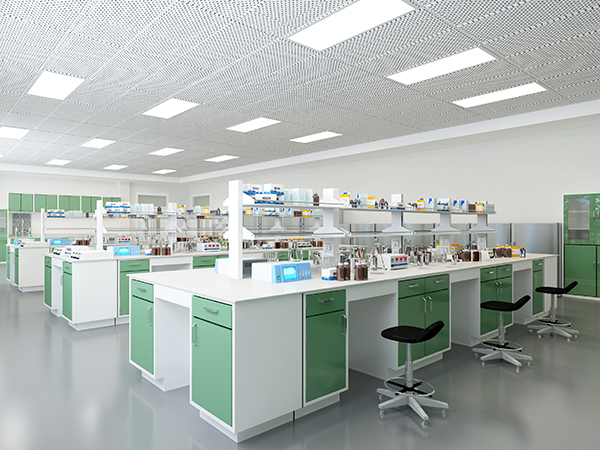Search
Search
Phone
Call
Mobile


The third part of the detailed explanation of the overall design planning of the textile laboratory construction, followed by the first part "Pure dry goods! The overall plan of textile laboratory construction"
(15) Instrument analysis room
The requirements of the instrument analysis room are higher than those of the pretreatment room. The instrument analysis room generally has air conditioning requirements, such as constant temperature and humidity, air purification, air flow, exhaust and other issues. Moisture-proof is required in areas with a relatively humid climate. For early laboratories, dry infrared lamps, small dehumidifiers, window air conditioners, and small independent air conditioners were used. Modern laboratories conditionally adopt central air-conditioning systems. For instruments and equipment with high requirements for anti-vibration, in addition to considering the location of the laboratory, it is also necessary to consider setting up an independent equipment anti-vibration foundation and vibration isolation measures. Instrument analysis laboratories generally require both AC and DC power supplies, as well as single-phase and three-phase power sockets, and often require voltage stabilization. Some also have requirements for electromagnetic interference prevention, such as grounding and electromagnetic shielding. Some require cooling water and various gas supplies, including vacuum and compressed air, protective gas and carrier gas. The laboratory construction standards of the instrument analysis room usually need to be considered higher: paint coatings or painted wall skirts for walls; wood floors, terrazzo floors, plastic floors, and marble floors for the floor; the laboratory bench for placing the instrument must be stable and can be used Terrazzo countertops of reinforced concrete structures, etc. Similarly, the laboratory requires dust and corrosion protection. Both should be given sufficient attention and properly resolved.
The instrument analysis room is mainly equipped with various large-scale precision analysis instruments, and also includes ordinary small-scale analyzers. These analysis rooms are composed of several small rooms, and the size and number of the rooms vary with various types of instruments; even for similar instruments, if their models are different, their requirements are often different, and sometimes there are big differences.
Analysis instruments commonly used in the construction of textile chemistry laboratories include chromatography-mass spectrometry, liquid chromatograph, ICP-spectrometer, atomic absorption spectrometer, spectrophotometer, etc. The requirements of each room are shown in the table below.
In the plane layout of the instrument analysis room, there are generally vibration-proof, dust-proof and relatively constant room temperature requirements and certain humidity requirements. The specific design should meet the requirements of the instrument product manual.
Instrument analysis rooms can usually be arranged along the outer wall like the pre-processing laboratory, or they can be concentrated in a certain area, which is conducive to the connection with various research rooms and basic laboratories, and unified considerations such as air conditioning, Measures such as protection.
When laying the floor of the instrument analysis room, it is sufficient to use a general fixed floor for the small ordinary instrument analysis room, but for the large precision instrument analysis laboratory, such as X fluorescence spectroscopy room, mass spectrometry room and other laboratory factors There are many cables and complicated pipelines, so it is necessary to use raised floors. When the air supply method is adopted, the space under the raised floor can also be used as the air supply static pressure box. The general floor structure has the following types:
(1) Shield type. When the number of cables is small, they can be tied into bundles and can be used for open wiring. In order to prevent damage to the wires, a protective cover can be added to the wires. The height of the protective cover should not hinder the switch of cabinet doors and windows.
(2) Trench type. Only make a trench under the floor where the cable passes. The size of the trench is generally 250mm wide and 150mm deep. The trench cover is cut into a movable cover, and a few aluminum flat handles are installed for easy opening.
(3) Raised floor. Also known as fabricated floor, it is composed of panel blocks of various specifications and materials, adjustable supports, beams, cushions, etc. Raised floor is laid overhead on the floor of the instrument room for installation of equipment, laying of various criss-crossing pipelines, cables and air-conditioning pressure boxes.
The raised floor should have excellent mechanical properties, light weight, high strength, flat surface, stable dimensions, flexible interchangeability, good decoration and texture, and meet the requirements of moisture-proof, flame-retardant, and anti-corrosion. Raised floor is divided into anti-static type and non-anti-static type.
Requirements and characteristics for the use of raised floors: ①It can be assembled easily and quickly regardless of the shape and area of the room; ②Free access to electrical connections and ducts, easy to lay and maintain; ③Load-bearing capacity>800kgm2; ④Satisfy fire prevention Requirements; ⑤It can make static electricity leak to the ground and reflect electromagnetic radiation; ⑥The detachable board of the floor can be interchanged, and has high production accuracy, so that the space under the floor can be used as an air-conditioning static pressure box to achieve the required sealing; ⑦ The surface of the board is noiseless, wear-resistant, and can be scrubbed or dry wiped (with a vacuum cleaner); ⑧The unevenness of the ground can be leveled with the help of an adjustable support.
Requirements for doors and windows in the instrument room: ①The room doors with air-conditioning and cleanliness requirements should be airtight and heat-preserving one-way spring doors or automatic door closers, and open to the room. Sound-proof doors should be used for the doors of rooms with strong noise that open to the computer room; ②When rooms with air conditioning and cleanliness requirements are set up for external education, they should be double-sealed windows. When using aluminum alloy windows and plastic steel windows, single-layer airtight windows with insulating glass can be used to ensure the thermal performance of the enclosure wall structure; ③The outdoor windows of the instrument should face north. If restricted by conditions, when the window opens to the east, south, or west, measures such as shading and curtains should be taken to prevent direct sunlight and avoid glare; ④The door of a room should ensure that people and equipment are easy to enter and exit.
Decoration requirements for the instrument room: ①The interior decoration of the precision instrument analysis room and the main auxiliary rooms should be made of easy-to-clean, non-dust-free, non-combustible materials, the walls and ceiling surfaces should be flat, reduce dust accumulation, and have heat preservation , Sound insulation and sound absorption effect. The floor material should be flat, wear-resistant, easy to remove dust, and anti-static measures should be taken as needed; ②General auxiliary room interior decoration can be designed according to the purpose of the room and according to relevant standards; ⑧Various indoor pipelines should be hidden, and when the pipeline passes through the floor, it is appropriate Set up a technical shaft; ④The air outlets, lamps, fire detectors, and fire extinguisher nozzles installed on the indoor ceiling, as well as various boxes on the wall, should be arranged in a coordinated manner to be neat and beautiful; ⑤The partition wall should be installed, except for the fixed wall Use flexible partitions to meet the needs of instrument renewal and expansion; ⑥The indoor color should be light, elegant and soft, with a fresh and quiet effect, and large-area strong colors are not suitable. Matte or matt surfaces should be used for furniture and rooms in the visual work area.

(16) Cleaning room
As a room for washing experimental supplies in the chemical laboratory building. The size of the room should be determined according to the daily workload, but generally should not be smaller than a single room (such as 24m2). The location of the washing room should be close to the pretreatment laboratory. There is usually a washing table in the room, hot and cold faucets on the pool, as well as drying ovens, drying boxes and drying racks. If an automatic washing machine is used, it should be considered to leave enough space around it to facilitate maintenance and loading and unloading of utensils. The workbench must be heat-resistant and acid-resistant. In addition, there should be space for parking large-scale trolleys. The room must have good ventilation facilities, and the width of the door should be able to pass trolleys. Double doors of one large and one small should be adopted. Terrazzo should be used on the ground, with good drainage slope and floor drain.
Laboratory construction where the experimental business is not too heavy can also be solved by each experimenter without a cleaning room.
 Phone
Phone
 Call
Call
 Address
Address

About us
Company Corporate image Video Center HonorFurniture testing equipment
Mattress testing equipmentOffice chair testing equipment Furniture comprehensive testing equipment Sofa testing equipment Formaldehyde testing instrument ...More testing equipmentLab planning customer cases
Laboratory engineering Medical engineering New material engineering Third party inspection project Clean house project maintenanceLaboratory engineering scheme
Reliability test scheme Mechanical test scheme of finished productEnvironmental simulation test schemeEnvironmental safety test program...More laboratory engineering solutionsDynamic and contact
Company news Industry Information Q&A Talent Recruitment Online message Contact Huahong